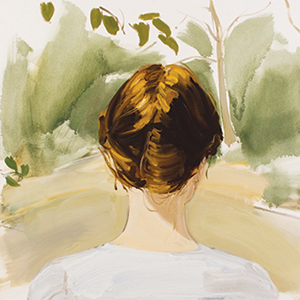Arts
Gideon Rubin Tells Human Stories With Faceless Figures
each viewer a chance to read into the paintings however they wish.
 EXPRESSIONLESS: Gideon Rubin gives the viewer plenty of detail, but never shows the face of his subject. Pictured: 'Braids.'
EXPRESSIONLESS: Gideon Rubin gives the viewer plenty of detail, but never shows the face of his subject. Pictured: 'Braids.'
The title of Gideon Rubin's first public solo show in the U.S. is taken from a line of poetry. In "Delivering Newspapers," the Chinese poet Bei Dao alludes to the disposable nature of news: "The nation has lost its memory/Memory goes as far as this morning."
In this digital age of taking, sharing, scrolling through and ultimately disposing of myriad selfies, the collective unconscious has become a blurred record of far too many faces frozen in rictal grins. Peruse Rubin's new collection of faceless portraits and you'll find an artist actively looking at our profound ability to forget.
Class of 1947 is a grouping of twelve small paintings, which together mimic a page from a high school yearbook as they hang close together on the wall. In rows of three and columns of four, each young woman wears the same pale rose dress. They could be debutantes.
The hair colors and styles differ, as do the placement of accurate neckline shadows, but each face is erased. What could read as a gimmick turns instead toward an anonymous and disconcerting sense of self. This could be your sister's group of high school friends, your mother's, your grandmother's. By concentrating on all the painterly details—the folds and creases of a dress, the arc of a specific neck, someone's particular shade of auburn—Rubin engages the viewer in an estranged nostalgia.
In the painting Three Girls you could even say a mood of anti-nostalgia prevails. The context is deliberately blotted out: Who are they? What are they looking at? What do they see? The three girls stand in 1960s mini-skirts—two of their profiles still intact, staring westward on a background of sage and smudge. There are family albums everywhere filled with images like these. Our minds too are stuffed with adjacent, concordant memories like these. It's this flesh-toned blankness of the faces, the minimal backgrounds that draw you in. The simple act of looking summons up those memories; they're easily placed inside the painting.
There is another, opposite reaction when you're walking through a gallery that's occupied with effacement—a longing for a portrait married to someone's individual identity. A mustache, eyebrows, the curve of a lip, or even an opaque expression. Despite a back catalogue that offers proof of his skillfully rendered and recognizable human faces, Rubin is ever prepared for the inevitable question, "Why are there no faces?"
"My work has always been between figuration and abstraction somehow," he says. "By not painting the face, you don't have to focus on this, you focus on an abstract. You focus on everything else, (the face) becomes a shape, it becomes a form, it becomes a form with its own rules of paint, which is as real as everything else in the painting."
An element of biography is also at play. Rubin happened to be in New York City visiting a friend on 9/11. "When I came back to London from September 11, I could not paint the way I painted before," he recalls. "I started painting these old toys just when I got back, straight away. But these were not two or three months to finish a painting, these were very immediate. One sitting, one hour, two hours, two paintings a day. They were influenced by people like Giorgio Morandi, just having a still life."
Portraits as still lifes. As a witness to 9/11, and, not incidentally, a member of a family with Holocaust survivors, Rubin's series of Memory paintings serves as a poignant memorial of absence and presence. The pain of calling up specific memories is soothed over in snapshots of lost relatives and friends. By omitting their personal features, the artist distills the human form down to its universal essence, and restricts the pain of remembrance to the size of a canvas.
Gideon Rubin: Memory goes as far as this morning
Thru-May 22, TK, $TK
San Jose Institute of Contemporary Art


